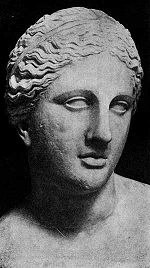
Colonna Venus
Encyclopedia

Praxiteles
Praxiteles of Athens, the son of Cephisodotus the Elder, was the most renowned of the Attic sculptors of the 4th century BC. He was the first to sculpt the nude female form in a life-size statue...
, conserved in the Museo Pio-Clementino
Vatican Museums
The Vatican Museums , in Viale Vaticano in Rome, inside the Vatican City, are among the greatest museums in the world, since they display works from the immense collection built up by the Roman Catholic Church throughout the centuries, including some of the most renowned classical sculptures and...
as a part of the Vatican Museums
Vatican Museums
The Vatican Museums , in Viale Vaticano in Rome, inside the Vatican City, are among the greatest museums in the world, since they display works from the immense collection built up by the Roman Catholic Church throughout the centuries, including some of the most renowned classical sculptures and...
' collections. It is now the best-known and perhaps most faithful Roman copy of Praxiteles' original.
The Colonna Venus
Venus (mythology)
Venus is a Roman goddess principally associated with love, beauty, sex,sexual seduction and fertility, who played a key role in many Roman religious festivals and myths...
is one of four marble Venuses presented in 1783 to Pope Pius VI
Pope Pius VI
Pope Pius VI , born Count Giovanni Angelo Braschi, was Pope from 1775 to 1799.-Early years:Braschi was born in Cesena...
by Don Filippo Giuseppe Colonna (1760-1818); this, the best of them, was published in Ennio Quirino Visconti
Ennio Quirino Visconti
Ennio Quirino Visconti was an Italian antiquarian and art historian, papal Prefect of Antiquities, and the leading expert of his day in the field of ancient Roman sculpture....
's catalogue of the Museo Pio-Clementino
Vatican Museums
The Vatican Museums , in Viale Vaticano in Rome, inside the Vatican City, are among the greatest museums in the world, since they display works from the immense collection built up by the Roman Catholic Church throughout the centuries, including some of the most renowned classical sculptures and...
, where it was identified for the first time as a copy of the Cnidian Venus. Immediately it eclipsed the somewhat flaccid variant of the same model that, as the Belvedere Venus, had long been in the Vatican collections. During the 19th and early 20th centuries, a prudish tin drape was modestly wrapped around the legs of the Colonna statue - this was removed in 1932 (Haskell and Penny 1981:331), when the statue was removed to the Gabinetto delle Maschere where it may be seen today.

